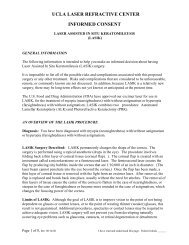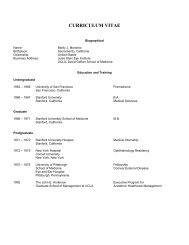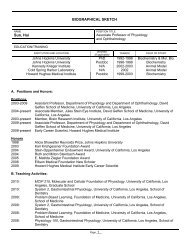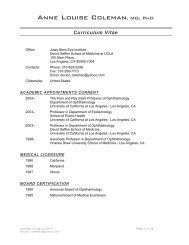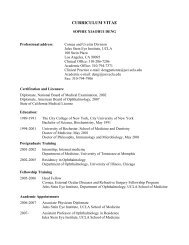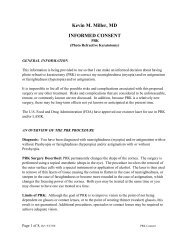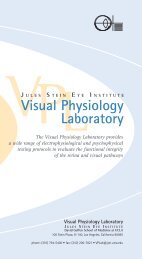View Annual Report - Jules Stein Eye Institute
View Annual Report - Jules Stein Eye Institute
View Annual Report - Jules Stein Eye Institute
Create successful ePaper yourself
Turn your PDF publications into a flip-book with our unique Google optimized e-Paper software.
70 Faculty<br />
PROFessIONaL ReseaRch seRIes<br />
Novruz ahmedli, PhD<br />
Associate Research Ophthalmologist<br />
ReseaRch summaRy<br />
Studies on Müller Cells<br />
Zbed4 is a multifunctional protein that plays a key role<br />
in the cells where it is expressed. Dr. Ahmedli’s results<br />
indicate that this important protein appears early in<br />
embryonic life and while in mouse retina it is detected<br />
only in Müller cells, in humans it is expressed in cones<br />
and Müller cells. In addition, he has found that the length<br />
and shape of Müller cell processes depend on the levels<br />
of Zbed4. Dr. Ahmedli’s work aims to identify the pathway,<br />
which is essential for proper functioning of Zbed4<br />
in Müller cells.<br />
christian altenbach, PhD<br />
Research Ophthalmologist<br />
ReseaRch summaRy<br />
Structure and Function of Rhodopsin<br />
The membrane protein rhodopsin is a critical first step<br />
in visual transduction, converting light energy into a<br />
chemical form in the photoreceptor cell of the eye. To<br />
understand this process on a detailed molecular level,<br />
Dr. Altenbach is using site-directed spin labeling and<br />
electron paramagnetic resonance spectroscopy to study<br />
the structure of rhodopsin in the absence of light, as<br />
well as the changes in structure caused by light.<br />
Barry L. Burgess, Bs<br />
Research Specialist IV<br />
ReseaRch summaRy<br />
Ocular Melanoma Molecular Genetics<br />
Mr. Burgess provides research support for the<br />
Ophthalmic Oncology Center under the direction of<br />
Tara A. McCannel, MD, PhD. His research interests<br />
include investigation of cytogenetic abnormalities of<br />
ocular melanoma and gene discovery for the metastatic<br />
form of this cancer. He has developed highly characterized<br />
cell lines from both primary ocular melanomas and<br />
metastatic lesions to complement the Center’s study<br />
of biopsy material. His research goals are to identify<br />
biochemical pathways that lead to a metastatic outcome<br />
and to find targets for therapeutic intervention<br />
that may preempt the progression of metastatic disease.<br />
Rajendra Gangalum, PhD<br />
Assistant Research Specialist II<br />
ReseaRch summaRy<br />
Function and Regulation of<br />
Small Heat Shock Protein αB-crystallin<br />
in Health and Disease<br />
Dr. Gangalum’s research seeks to gain understanding<br />
of the physiological function of αB-crystallin in the<br />
developing ocular lens and nonocular tissues.<br />
αB-crystallin has been shown to associate with pathologies<br />
such as cataracts, cancer, age-related macular<br />
degeneration (AMD), and other neurodegenerative dis-<br />
eases. Dr. Gangalum has discovered that αB-crystallin<br />
is a Golgi-associated membrane protein, secreted into<br />
extracellular medium via exosomes from retinal pigment<br />
epithelial cells. These findings explain how αB-crystallin<br />
is detected in the protein-lipid deposits know as drusen<br />
in AMD. Dr. Gangalum has generated the transgenic<br />
mice model of childhood cataract to study the molec-<br />
ular basis of its pathology. Cataracts in infants are<br />
debilitating, because opacities in the lens hinder the<br />
transmission of light to the retina, which impairs the<br />
development of visual cortex in the brain. This model<br />
system is the only paradigm available for future investigations<br />
on early childhood cataracts.<br />
yekaterina Gribanova, mD<br />
Assistant Research Specialist III<br />
ReseaRch summaRy<br />
Characterization of Novel<br />
Retinal Protein 7R<br />
A novel retinal protein, 7R, has been linked to autosomal<br />
recessive retinitis pigmentosa, a disease leading<br />
to incurable blindness. Dr. Gribanova is using<br />
immunohistochemical analysis, in situ proximity ligation<br />
assay, co-immunoprecipitation, immunoelectron cryomicroscopy,<br />
and gradient flotation fractionation combined<br />
with solid-phase immunoadsorption to determine<br />
and characterize 7R function in photoreceptor cells.<br />
These methods will identify 7R’s interacting partners<br />
and indicate whether 7R is contributing to the sorting<br />
and transport of phototransduction proteins to the outer<br />
segment of photoreceptor cells.




